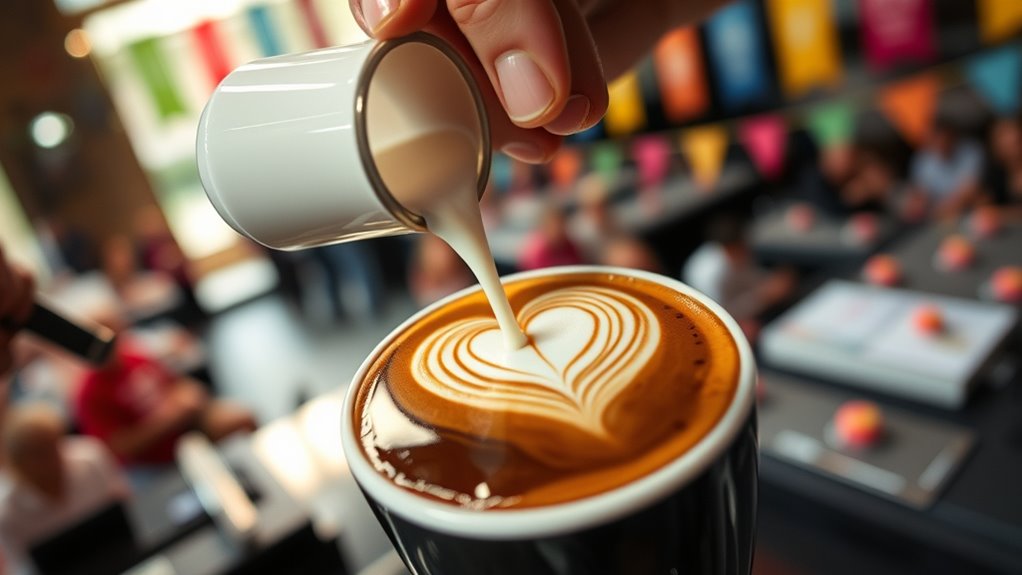In the world of coffee art competitions, your skills in milk foam techniques, control, and precision are key to creating stunning and intricate designs. Judges look for complex, symmetrical, and artistic creations that showcase technical mastery and creative flair. Practice helps you develop confidence, adaptability, and finesse, while choosing the right materials and presentation enhances your work’s impact. Stay tuned to discover how mastering these elements can elevate your latte art to new heights.
Key Takeaways
- Coffee art competitions showcase artists’ mastery of milk foam techniques and creative latte designs.
- Judging criteria focus on design complexity, symmetry, color contrast, and presentation finesse.
- Participants continually practice to improve control, consistency, and adaptability during live performances.
- Successful competitors blend technical skills with artistic expression for innovative and eye-catching designs.
- Presentation, including choice of tableware and overall visual impact, elevates the artistic value of coffee art.

Coffee art competitions have become a vibrant platform for baristas and artists to showcase their creativity and skill. When you participate or watch, you quickly realize that mastering milk foam techniques is essential. The quality of your milk foam can make or break your design, so you focus on creating smooth, velvety textures that hold their shape. Achieving the perfect microfoam isn’t just about aesthetics; it’s about control, temperature, and technique. You learn to steam milk to the right consistency, creating a glossy, paint-like surface that’s ideal for pouring intricate patterns. The better your milk foam techniques, the more precise and detailed your latte art can be, impressing both judges and audiences.
Mastering milk foam is essential for stunning latte art and winning coffee competitions.
In these competitions, competition judging plays a fundamental role. Judges evaluate each entry based on several criteria: the complexity of the design, symmetry, color contrast, and the overall presentation. They look for consistency in the foam’s texture and the artist’s ability to execute the design with finesse. You might feel nervous as judges scrutinize your work, but understanding what they’re looking for helps you prioritize your technique and creativity. Precision is key, and judges appreciate artistry that balances technical skill with originality. Your ability to handle milk foam techniques under pressure often determines your success, especially when aiming for high scores in competition judging.
As you prepare for these events, you realize that practicing your milk foam techniques repeatedly sharpens your skills. Each pour becomes more controlled, allowing you to create more complex and detailed latte art. You also learn to adapt your designs to the unique qualities of each milk and espresso shot, which is indispensable during the live competition. Watching seasoned artists, you notice how they seamlessly combine technical mastery with artistic expression, all while maintaining a calm focus. During judging, you learn that your confidence and consistency matter just as much as your creativity. The best competitors are those who can blend technical prowess with innovative designs, elevating latte art from simple patterns to enthralling works of art.
Furthermore, understanding tableware materials and their influence on presentation can enhance the overall aesthetic of your coffee art, making your creations stand out even more. You discover that material choice can affect how well your design is viewed and appreciated, adding an extra layer of thoughtfulness to your presentation. In the end, coffee art competitions aren’t just about making pretty designs—they’re about pushing your limits, refining your milk foam techniques, and understanding the nuances of competition judging. You leave inspired, enthusiastic to experiment further, and more committed to perfecting your craft. Whether you’re competing or simply appreciating the artistry, these events celebrate the passion and skill behind every beautifully crafted latte.
Frequently Asked Questions
How Do Judges Score Latte Art Competitions?
When judges score latte art competitions, they look at your milk foam textures and the precision of your design. They also consider how well you incorporate different coffee bean varieties to enhance flavor and presentation. Your technique, symmetry, and creativity matter, along with the overall visual impact. Judges evaluate consistency and skill, rewarding those who demonstrate mastery of milk textures and thoughtful use of coffee bean varieties to create striking, balanced art.
What Skills Are Essential for Aspiring Coffee Artists?
Imagine the swirl of milk frothing perfectly as you master your pouring technique, transforming simple coffee into art. To excel, you need keen attention to detail, steady hands, and a creative eye. Practice consistently, experiment with different patterns, and refine your skills. Developing an intuitive sense of milk texture and flow helps you craft intricate designs, making your coffee not just a drink, but a masterpiece that captures both skill and passion.
How Has Coffee Art Evolved Over the Years?
You can see how coffee art has evolved through its rich history, from simple patterns to intricate designs. Over the years, latte art trends have shifted towards more creative and complex styles, reflecting both technological advances and artistic experimentation. Today, you’re part of a dynamic world where innovation and tradition blend to push coffee art’s boundaries, making each cup a unique canvas for your skills and imagination.
Are There Regional Differences in Latte Art Styles?
Regional rhythms and cultural influences shape distinct latte art styles across the globe, so you’ll notice unique trends from place to place. In Italy, you’ll find traditional tulips and rosettas, while Japan’s intricate designs reflect their artistic precision. In the U.S., creative and experimental styles thrive, blending boldness with beauty. These regional trends showcase diverse traditions and tastes, making every latte a cultural canvas you can explore and enjoy.
What Equipment Is Best for Practicing Latte Art at Home?
For practicing latte art at home, you want quality equipment like a good espresso machine with a steam wand, a frothing pitcher, and fresh milk. Focus on equipment maintenance to keep your tools in top shape, ensuring smooth pours. Consistent home brewing helps you improve your skills faster. Invest in a thermometer and practice regularly to master different designs. With the right gear and maintenance, you’ll elevate your latte art game quickly.
Conclusion
As you watch a barista craft intricate latte art, it’s like witnessing a painter bring a blank canvas to life with just milk and espresso. These competitions showcase not only skill but passion and patience—much like tending a delicate garden. Remember, every pour is a small act of artistry, transforming simple ingredients into a masterpiece. So, next time you order a latte, appreciate the artistry behind it—you’re truly tasting a work of heart.









